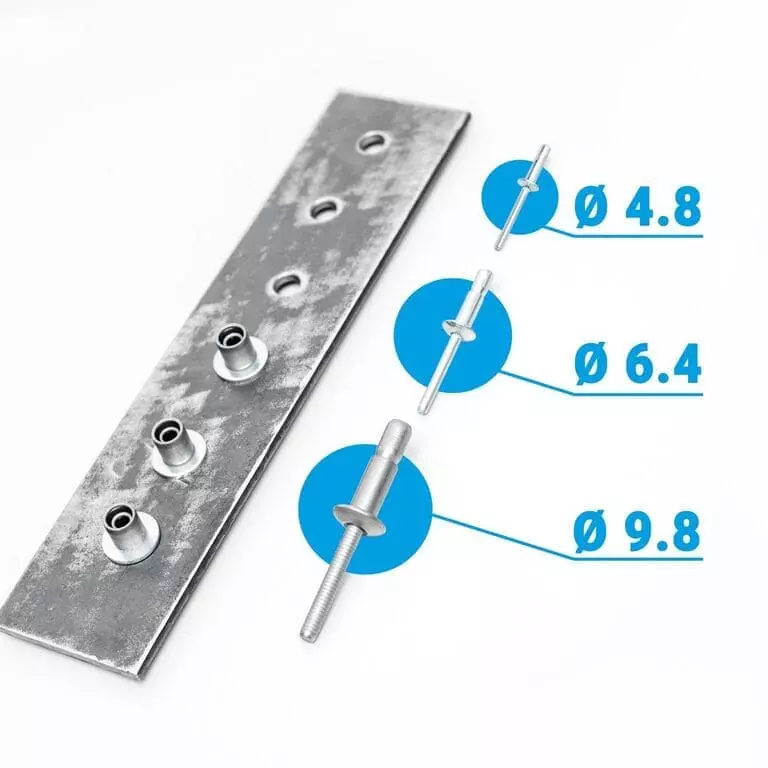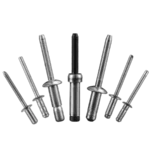Metric Blind Pop Rivet Hole Size Chart
The Metric Blind Rivet Hole Size Chart is a key tool for ensuring the quality and structural reliability of riveted joints. By accurately matching the rivet diameter with the drill hole size, it helps users to achieve a stable and solid connection, avoiding problems such as loosening caused by too large a hole diameter and installation difficulties caused by too small a hole diameter. The comparison table is widely used in process setting, drill selection, assembly process standardization and quality control, and is an indispensable technical basis for precision manufacturing and batch assembly.
| Rivet Diameter (inch / mm) | Recommended Hole Size (mm) | Drill Size (Inch / #) | Typical Grip Range (mm) | Common Rivet Materials | Common Base Materials |
|---|---|---|---|---|---|
| 1/16″ (1.6 mm) | 1.63 – 1.70 mm | #52 (~1.63 mm) | 0.5 – 1.5 mm | Brass, Copper, Aluminum | Thin aluminum sheet, plastic |
| 3/32″ (2.4 mm) | 2.5 – 2.6 mm | #43 (2.46 mm) | 0.5 – 3.2 mm | Aluminum, Steel, Copper | Electronics, appliance housing |
| 1/8″ (3.2 mm) | 3.3 – 3.4 mm | #30 (3.26 mm) | 0.8 – 6.4 mm | Aluminum, Steel, Stainless Steel | Light metal frame, enclosures |
| 5/32″ (4.0 mm) | 4.1 – 4.2 mm | #20 (4.08 mm) | 1.6 – 9.5 mm | Steel, Stainless Steel, Aluminum | Sheet metal, HVAC ducts |
| 3/16″ (4.8 mm) | 4.9 – 5.0 mm | #11 (4.88 mm) | 1.6 – 12.7 mm | Steel, Stainless, Structural | Automotive, equipment housing |
| 6.0 mm | 6.1 – 6.3 mm | 15/64″ (~6.0 mm) | 2.0 – 14.0 mm | Steel, Stainless Steel | Heavy gauge steel, furniture |
| 1/4″ (6.4 mm) | 6.5 – 6.6 mm | F drill (6.51 mm) | 2.5 – 16.0 mm | Structural Steel, SS | Automotive frame, heavy panels |
| 8.0 mm | 8.1 – 8.3 mm | 21/64″ (~8.33 mm) | 3.0 – 18.0 mm | Structural Steel, SS | Container assembly, rail sector |
Description:
- Recommended Hole Size is a range of diameters of holes to be drilled prior to rivet installation and should be slightly larger than the body diameter of the rivet to allow for tail expansion.
- Drill Size provides a common match for inch/number drills to assist in selecting the proper drill tool.
- Grip Range is the range of material thicknesses that the rivet is designed to grip and should be selected based on the total layer thickness.
- Material Compatibility is recommended in conjunction with the electrochemical compatibility of the rivet with the base material (to avoid galvanic corrosion).
What is a Metric Blind Rivet Hole Size Chart?
The Blind Rivet Hole Size Chart is a standardized reference that lists the recommended hole diameters, matching drill types, grip ranges and common application materials for each blind rivet size. Simply put, this table is the basis for selecting the correct hole size for riveting operations.

# Why is it important to refer to Metric Blind Rivet Hole Size Chart?
- Ensure solid riveted joints: Only by drilling holes in accordance with the recommended hole diameter can the rivet expand correctly and clamp the base material tightly during the core pulling process. If the hole diameter is too large, the rivet will not be able to form enough clamping force after expansion and the connection will be loose; if the hole diameter is too small, the rivet will not be able to be inserted smoothly or the deformation will be poor, or even cause damage to the base material.
- Ensure structural strength and durability: The correct hole diameter can maximize the tensile force and shear force of the riveted joint to meet the design requirements.
- Improve installation efficiency and consistency: Through the use of standardized apertures, the consistency of each rivet installation can be ensured in high-volume assembly or automated production, reducing rework rates and potential quality hazards.
- Facilitate tool selection and process specification: Referring to the hole size table, you can quickly determine the type of drill you need to match and set the parameters of the drilling machine.
why is correct hole size important for blind riveting?
The correct hole size is critical for blind riveting because it directly determines whether the rivet can expand correctly in the base material, clamp sufficiently and form a stable connection structure. If the hole size is not selected properly, it can have a series of serious effects on the performance of the connection, and even lead to riveting failure.
The correct hole size will result in the following features:
- Ensure proper rivet expansion and molding
- Safeguard clamping force
- Maintains shear resistance
- Improved waterproof sealing performance

# The Consequences of the Wrong blind rivet hole Size
| Error Type | Consequences |
|---|---|
| Hole too large | – Insufficient rivet expansion, reduced clamping force – Loosening and failure under vibration – Poor sealing, water ingress possible |
| Hole too small | – Rivet difficult to insert or mandrel cannot break – Excessive installation stress, possible material damage – Incomplete tail expansion, resulting in weak grip |
| Rough or irregular hole | – Rivet gets stuck or misaligned during expansion – Uneven fastening, reduced structural strength |
| Hole drilled at incorrect angle | – Rivet experiences uneven stress – Connection prone to tearing or fatigue cracks |
How to read a blind rivet hole size chart?
- Rivet Diameter: The body diameter of the rivet in inches or millimeters, which determines the basic hole size.
- Recommended Hole Size: The diameter of the recommended hole, usually slightly larger than the body diameter of the rivet, to facilitate insertion and expansion.
- Drill Size: Corresponds to a standard drill bit size (inch numbered bit, such as #30, or metric size, such as 3.3mm).
- Grip Range: The total range of material thicknesses that can be effectively gripped by the rivet.
- Typical Materials: Recommended riveting base material types, such as aluminum, steel, stainless steel, plastic, etc..
Correctly interpreting the blind rivet hole size chart = Choosing the right rivet + Matching drill bit + Consistent riveting quality.
Factors affecting the choice of hole size
The rivet body diameter is the most direct factor in determining the basic hole diameter.
It is usually recommended that the hole diameter is approximately 0.1mm-0.3mm larger than the rivet diameter to allow for insertion and expansion space.
- Aluminum rivets: soft, expansion is larger, hole diameter can be slightly smaller to enhance the clamping force.
- Steel / stainless steel rivets: hard, limited expansion, hole diameter needs to be slightly larger to prevent pulling off the mandrel or parent material damage.
- Copper / brass rivets: medium strength, the requirements of the hole diameter should be easy to insert, but also to ensure dense expansion.
# Base Material
- Soft materials (plastic, thin aluminum): hole diameter can be slightly smaller, the use of material flexibility to improve the locking effect.
- Hard material (steel plate, stainless steel plate): need to drill holes accurately, to avoid extrusion of rivets during assembly or material damage.
The closer the clamping thickness is to the upper limit of the rivet’s Grip Range, the smaller the expansion space is, and the higher the requirement for hole accuracy. If the material thickness varies greatly (such as multi-layer structure), should consider the neutral hole diameter matching to ensure uniform force.
# Types of Riveting Processes
- Conventional blind rivets: follow standard hole size requirements.
- Structural blind rivets (e.g., core lock, closed end): may require a slightly larger hole size to ensure smooth breakage of the internal core.
- Self Piercing Rivets (SPR): no pre-drilling required, only for soft materials and thin plates.
# Watertight sealing requirements
If the riveted joint needs to be watertight, the hole size should be more tightly controlled to avoid the formation of gaps.
Seals and blind rivets with closed ends can be used to enhance the protection effect.
Common mistakes when selecting rivet hole size
1. Rivet hole too large
When the hole diameter is significantly larger than the recommended standard, the rivet connection strength of the completed installation is extremely low. If subjected to vibration, shear, or external tension, the rivets are highly susceptible to slipping or falling; and the loss of waterproof sealing performance can lead to water seepage or corrosion problems. In high-volume assemblies, excessive hole sizes can lead to batch rework or product recalls.
2. Rivet hole too small
When the hole diameter is smaller than the recommended standard, the tail of the rivet core pulling can not be fully expanded, which will lead to insufficient clamping force. Or the rivet core bar is difficult to pull off, or even lead to incomplete core bar breakage or deformation of the rivet body.
3. Drill wear
If you are drilling with a badly worn drill bit, it can lead to a significant deviation of the actual hole diameter from the expected hole diameter, which can be small or large.
- Large hole diameter ➔ Rivet slips loose and risk of failure increases;
- Small hole size ➔ Difficult installation, abnormal core pulling, insufficient clamping force;
- Overall riveting quality decreases during batch production, and errors tend to spread over large areas;
- Increased cost of rework, affecting delivery cycle and reputation.


